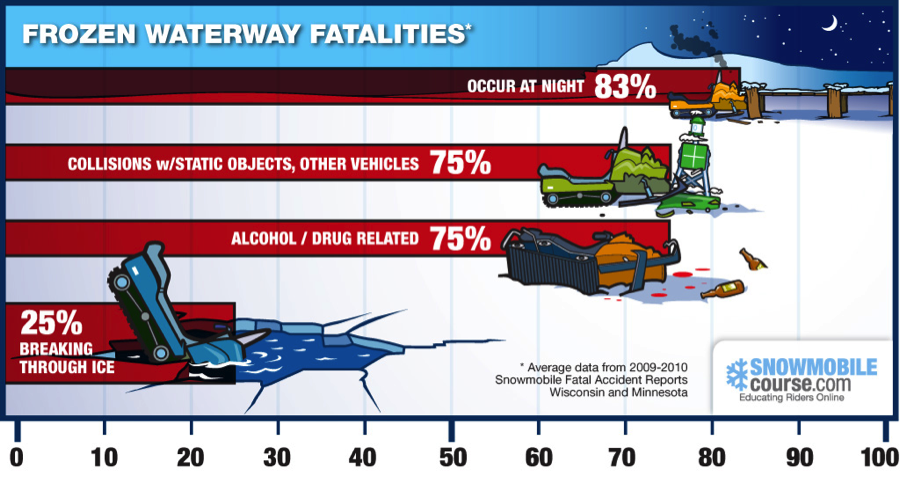Snowmobile Safety Week Tip: Preparing to Ride Across the Lake
January 23, 2012
by Brent McNamee
Most snowmobile accidents featured on the news seem to involve a trip across a frozen lake/river gone wrong. With International Snowmobile Safety Week now coming to a close, it's a good time to review some recent statistics about serious snowmobile accidents. We looked at the 2009-2010 Snowmobile Fatal Accident Reports from Wisconsin and Minnesota. This is what we found.
Across the two states, 30% of all snowmobile-related fatalities occurred on a frozen lake or river. We were most surprised to find that of these fatalities only 25% resulted from breaking through the ice. The other 75% resulted from collisions with fixed objects, such as docks, rocks, ice huts or bridges, or other snowmobiles and vehicles.
In both states, alcohol and/or drug use was a common risk factor for snowmobile accidents on waterways. Of all fatal accidents occurring on frozen waterways, 75% involved drugs or alcohol.
However, the most common risk factor for fatal accidents on frozen water was lack of daylight. Over the 2009-2010 season, 83% of fatalities that occurred on frozen lakes or streams occurred at night.

These statistics suggest some clear tips for riding on frozen waterways.
- Don’t drink and ride.
Drinking always impairs judgment. And whether this means not checking ice conditions or driving too fast, lack of judgment and frozen (or not frozen) water can be deadly.
- Slow down (and slow down even more at night).
Especially at night, it’s hard to know what’s out there on the lake. Whether sketchy ice, a bridge column or an ice fishing hut, you won’t see it in time if you override your headlight.
- Check the condition of the ice.
Experts say there’s no way to know for sure if the ice is safe. That means extreme caution is required. Snowmobiles need 5 inches of clear solid ice. Check with a trusted local source (like a bait shop) and check the ice yourself when you get there.
- Don’t ride alone. And make a ride plan.
Riding with a buddy can be a lifesaver in any number of situations. Even if you are travelling with a friend, tell someone else your plan and check in when you arrive safely.
- Know what to do if you go through.
Going through the ice is a bad situation. But it doesn’t have to be fatal. Review what to do before you go out, and if something should happen, stay calm but act quickly. Carry ice picks and use them to pull yourself out on the edge where you broke through, which will be the most solid edge. This is a good video demonstrating the use of ice picks.